Why the Sony 400-800 on a Foggy Day? by Arthur Morris/BIRDS AS ART
When I first borrowed the Sony 400-800, I assumed that at 5.45 lbs. it was too heavy and that a f/8 on the long end it was too slow for general bird photography. Boy was I wrong. While photographing Roseate Spoonbills at Stick Marsh in March I fell in love with the lens and have used it pretty much every day since then. On a foggy morning in mid-June I opted to head out on Nickerson Beach with only the 400-800 and my a-1 II. It turned out to be the perfect choice despite the low light. Learn why in today’s 12-minute video, and learn a ton about shooting in the fog and about processing foggy images.
Your Call?
Which of today’s featured images is your top pick? Why did you make your choice?
The BIRDS AS ART SONY 400-800mm f/6.3-9 G Super-telephoto Zoom Lens Guide
When I borrowed this lens from Sony, I assumed that at 5.45 pounds it was too heavy to handhold for long and that at f/8 at the long end (800mm,) it was too slow for most bird photography applications. In short, I did not want to like the lens. After a month of using it, I cannot live without it. After returning the loaner, I was miraculously able to get my own from Bedfords on 16 April 2025. In this guide I share everything that I have learned about using the 400-800. For best results, you need to know exactly what you are doing to get the most out of this zoom lens. It would be best, therefore, to consider and study the material in the guide so that you can begin making great images with your new lens.
You will learn how to deal with the relatively show apertures: f/6.3, f/7.1, and f/8 when working in Manual mode.
You will learn how to ensure that you are working at the widest aperture by working in Shutter Priority mode with AUTO ISO.
If you are able to hand hold the lens, you will learn proper hand holding techniques.
If you can’t, you will learn when, why, and how to employ other options. Those include:
1- The knee-pod, heel-pod, and toe-pod techniques
2- Using the lens on a monopod.
3- The best lens plate and low foot for your 4-8.
4- The best tripod and head for the 4-8 and how best to utilize them.
5- How to use the lens from your vehicle while supporting it on a BLUBB (or not and why not).
6- Detailed instructions on how to set and use the lens controls and buttons:
a- AF/MF
b- DMF Switch
c- Limit Range Switch
d- OSS (Optical Steady Shot) Switch
e- OSS Mode Switch
f- Focus Hold Buttons
The guide also includes a Hand Holding Shutter Speed Primer and an illustrative, educational, and inspiring 67-image gallery.
Free to folks who use one of my two affiliate links to purchase their Sony 400-800 G lens. Otherwise, please send a PayPal for $115.43 to birdsasart@verizon.net and include the words “400-800 Lens Guide” in your e-mail.
What’s Up?
Photography down by the lakefront at Indian Lake Estates has been unexpectedly excellent since I got back from NYC. There has been a smattering of cooperative Black-bellied Whistling Ducks, young and adult Killdeer, Green Herons, a dancing Snowy Egret, pied juvenile Little Blue Heron, Great Egret, Tricolored Heron, two juvenile Ospreys, foraging Limpkins, a silly tame juvenile plumage Great Blue Heron on the pier railing, foraging Common Moorhens, both adult and young Sandhill Cranes, and, on Wednesday morning, 25 Black Vultures having a sipping party on the edge of the lake right in front me. That same morning I saw but did not get to photograph a Least Bittern, a rare sight at ILE.
Today is Thursday 26 January 2025. I will be heading down to the lake early in perfect conditions — sunny with a breeze from the northeast. After brunch, a swim, and an early nap, I will drive the almost four hours up to Jacksonville to photograph nesting Royal Terns (7000 pairs), Sandwich Terns (a few dozen pairs), and 10,000 pairs of Laughing Gulls, all with chicks of varying ages from tiny to fledged and flying. Despite offering practically free instruction, I still have room in the AirBnB from 29 June through 5 July (photographing on the last Sunday morning). If interested, shoot me a text to 863-221-2372 and include your e-mail address.
If it is cloudy in the afternoon, I might pop into the St. Augustine Alligator Farm to check on the crop of wading bird chicks. Whatever you opt to do, I hope that you too choose to have a wonderful and productive day and that you have fun too. Do remember that happiness is a choice — Byron Katie, The Work.Com.
If an item — a Delkin flash card, a Levered-clamp FlexShooter Pro, or a Wimberley lens plate — for example, that is available from B&H and/or Bedfords, is also available in the BAA Online Store, it would be great, and greatly appreciated, if you would opt to purchase from us. We will match any price. Please remember also to use my B&H affiliate links or to earn 3% cash back at Bedfords by using the BIRDSASART discount code at checkout for your major gear purchases. Doing either often earns you free guides and/or discounts. And always earns my great appreciation.
In the Last Blog Post
In the last blog post here, I responded to each and every comment and in addition, revealed my favorite image in my response to many multiple IPT veteran and good friend Monte Brown.
Gear Questions and Advice
Too many folks attending BAA IPTs and dozens of photographers whom I see in the field and on BPN, are — out of ignorance — using the wrong gear, especially when it comes to tripods and more especially, tripod heads. And the same is true in spades when ordering new camera bodies or lenses. My advice will often save you some serious money and may help you avoid making a seriously bad choice. Please know that I am always glad to answer your gear questions via e-mail. If you are desperate, you can try me on my cell at 863-221-2372. Please leave a message and shoot me a text if I do not pick up.
Don’t Just Shoot: Learn
If you are interested in changing your life and becoming a better photographer by joining me on an Extended IPT at Sebastian Inlet for Ospreys and more (SEPT 25 to NOV 24, 2025) in San Diego for Pacific-race Brown Pelicans and more (JAN 6 to FEB 2, 2026), for Roseate Spoonbills at Stick Marsh mid-March 2026, please e-mail for dates, rates, terms, and additional information. Or shoot me a text to 863-221-2372. All offerings include options for shared AirBnB lodging. Ground transportation during your stay is a possibility.
B&H Simplified
To ensure that I get credit for your B&H purchases, you can always click here. The tracking is invisible but using my affiliate links is greatly appreciated. And, with B&H, you can use your PayBoo card. You must use the website to order. You cannot get your free guides if you make a phone order. Once you have an item in your cart, you must complete the order within two hours. Huge thanks!
B&H
Many folks have written recently stating that they purchased a Sony a1 from B&H and would like their free membership in the Sony 1 Info and Updates Group, a $150.00 value. But when I check my affiliate account, their orders have not been there. When I let them know that they get credit for B&H purchases only if they use one of the many B&H affiliate links on the blog or begin their searches with this link, they are always disappointed. If in doubt, please contact me via e-mail and request a BH link. I am always glad to help and to guide you to the right gear.
Bedfords Simplified
Click here to start your search. Choose standard shipping, and when you get to the payment page, enter BIRDSASART in the discount code box and hit apply. You will be upgraded to free second day air Fed-Ex and receive 3% cash back on your credit card once your stuff ships. Using either my affiliate links is greatly appreciated and will often earn you free guides or discounts.
Bedfords Amazing BAA Discount Policy
Folks who have fallen in love with Bedfords can now use the BIRDSASART coupon code at checkout to enjoy a post-purchase, 3% off-statement credit (excluding taxes and shipping charges) on orders paid with a credit card. The 3% credit will be refunded to the card you used for your purchase. Be sure, also, to check the box for free shipping to enjoy free Second Day Air Fed-Ex. This offer does not apply to purchases of Classes, Gift Cards, prior purchases.
Visit the Bedfords website here, shoot Steve Elkins an e-mail, or text him on his cell phone at (479) 381-2592.
|
|
|
This image was created on 19 June 2025 at Nickerson Beach Park, Lido Beach, Long Island, New York by William Wang. He used the handheld iPhone 13 Pro Max with the iPhone 13 Pro Max back triple camera 9mm f/2.8 lens. ISO 32: 1/200 sec. at f/2.8. Image #1: artie heading into the fog at Nickerson Beach |
Thrilled
I was thrilled when I received an e-mail from William Wang with an iPhone photo of yours truly heading into the fog at Nickerson Beach on the morning of 19 June. Traveling light with the 400-800/a-1 II rig (without a tripod!) is my idea of fun. And despite the low light and the f/8 aperture at the long end, I made some quite excellent images.
|
|
|
This image was created on 19 June 2025 at Nickerson Beach Park, Lido Beach, Long Island, New York. Crouching a bit, I used the handheld Sony FE 400-800mm f/6.3-8 G OSS lens (Sony E) (at 725mm) and The Latest Greatest Sony Flagship Body, the a1 II Mirrorless Camera. Multi-metering +2.0 stops in Shutter Priority mode with Exposure Compensation (EC) on the Thumb Dial. AUTO ISO set ISO 5000: 1/1250 sec. at f/8 (wide open). AWB at 6:27:02am on a then foggy morning. Wide/AF-C with Bird-Eye/Face Detection performed perfectly. Click on the image to enjoy the larger, inexplicably sharper high-res version. Image #2: Black Skimmer, adult with Atlantic Silversides (spearing) |
Optimizing Foggy Images
Simply by adjusting the sliders under the Light tab in Adobe Camera Raw just as I do for every image, the very foggy raw file was brought to life. Learn how in Digital Basics II and in the Digital Basics III Video Series.
You can view the foggy raw file in the YouTube video above.
|
|
|
This image was also created on 19 June 2025 at Nickerson Beach Park, Lido Beach, Long Island, New York. Seated on damp sand I used the knee-pod technique with the handheld Sony FE 400-800mm f/6.3-8 G OSS lens (Sony E) (at 800mm) and The Latest Greatest Sony Flagship Body, the a1 II Mirrorless Camera. The exposure was determined by Zebras with ISO on the rear wheel — ISO 4000: 1/1000 second at f/8 (wide open) in Manual mode. RawDigger showed that the exposure was dead-solid perfect. AWB at 6:40:12am on a then foggy morning. Wide/AF-C with Bird-Eye/Face Detection performed perfectly. Click on the image to enjoy the larger, inexplicably sharper high-res version. Image #3: American Oystercatcher fledgling flapping after bath |
Do Not Fear the High ISO Settings
When working in low light with the 400-800, you will — on occasion, need to use some high ISO settings. My double noise reductions techniques detailed in both in Digital Basics II and in the Digital Basics III Video Series can help you to create pleasing, virtually noise-free images with ISOs as high as 12,800.
I was a bit lucky that the 1/1000 sec. shutter speed that I chose was fast enough to freeze the action. Again, you can see the foggy raw file in the YouTube video above.
|
|
|
This image was also created on 19 June 2025 at Nickerson Beach Park, Lido Beach, Long Island, New York. Seated on dry sand and working off the tilted rear monitor, I used the heel-pod technique with the handheld Sony FE 400-800mm f/6.3-8 G OSS lens (Sony E) (at 700mm) and The Latest Greatest Sony Flagship Body, the a1 II Mirrorless Camera. The exposure was determined by Zebras with ISO on the rear wheel — ISO 2000: 1/500 second at f/11 (stopped down one stop) in Manual mode. RawDigger showed that the exposure was dead-solid perfect. AWB at 7:00:00am on a then foggy morning. Wide/AF-C with Bird-Eye/Face Detection performed perfectly. Click on the image to enjoy the larger, inexplicably sharper high-res version. Image #4: Common Tern with chick at nest scrape |
Degrees of Low-ness
Compare this image with Image #5 below to see the difference in perspective between photos made with the ultra-low heel pod technique and those made with the knee-pod technique.
|
|
|
This image was also created on 19 June 2025 at Nickerson Beach Park, Lido Beach, Long Island, New York. Seated on dry sand I used the knee-pod technique with the handheld Sony FE 400-800mm f/6.3-8 G OSS lens (Sony E) (at 800mm) and The Latest Greatest Sony Flagship Body, the a1 II Mirrorless Camera. The exposure was determined by Zebras with ISO on the rear wheel — ISO 1250: 1/1000 second at f/9 (stopped down 1/3-stop) in Manual mode. RawDigger showed that the exposure was dead-solid perfect. AWB at 7:19:33am on a then foggy morning. Wide/AF-C with Bird-Eye/Face Detection performed perfectly. Click on the image to enjoy the larger, inexplicably sharper high-res version. Image #5: Common Tern week-old chick striding with foot raised |
A Huge Knee-Pod Technique Advantage
Though I love the ultra low perspective that comes when employing the various foot-pod techniques, it is extremely difficult (at best) to follow a running bird. That is much easier to do using the knee-pod technique because your eye is at the viewfinder.
|
|
|
This image was also created on 19 June 2025 at Nickerson Beach Park, Lido Beach, Long Island, New York. Seated on dry sand I used the handheld Sony FE 400-800mm f/6.3-8 G OSS lens (Sony E) (at 800mm) and The Latest Greatest Sony Flagship Body, the a1 II Mirrorless Camera. The exposure was determined by Zebras with ISO on the rear wheel — ISO 2000: 1/3200 second at f/8 (wide open) in Manual mode. RawDigger showed that the exposure was dead-solid perfect. AWB at 7:45:39am on a then foggy morning. Wide/AF-C with Bird-Eye/Face Detection performed perfectly. Click on the image to enjoy the larger, inexplicably sharper high-res version. Image #6: Common Tern kiting into west wind — back shot — foggy version |
Foggy Image Optimization Choice I
The photographer can control the look of images made in foggy conditions. Image #6 maintains the foggy look quite well.
Why the Back Flight Shot?
Understand that when the wind if from the west in the morning that flight shots with the bird facing directly away from you may be the best option; they often yield lovely views of the dorsal wing surfaces and interestingly symmetrical wing positions.
|
|
|
This one was created from the same raw file as Image #6. Image #6A: Common Tern kiting into west wind — back shot — moderate contrast version |
Foggy Image Optimization Choice II
With 6A, I increased the contrast a bit to the degree that there is not much visible fog remaining.
|
|
|
This one was also created from the same raw file as Image #6. Image #6B: Common Tern kiting into west wind — back shot — high contrast version |
Foggy Image Optimization Choice III
This was my first attempt but I realized that the I had made the dorsal wing surfaces too dark. So, I went back a first created 6A and finally the foggiest version, Image #6.
Image Question
Which of the three foggy image optimizations do you like best, 6, 6A, or 6B? Why?
|
|
|
This image was also created on 19 June 2025 at Nickerson Beach Park, Lido Beach, Long Island, New York. Seated on dry sand I used the handheld Sony FE 400-800mm f/6.3-8 G OSS lens (Sony E) (at 720mm) and The Latest Greatest Sony Flagship Body, the a1 II Mirrorless Camera. The exposure was determined by Zebras with ISO on the rear wheel — ISO 2000: 1/3200 second at f/8 (wide open) in Manual mode. RawDigger showed that the exposure was dead-solid perfect. AWB at 8:35:07am on a then-sunny morning. Wide/AF-C with Bird-Eye/Face Detection performed perfectly. Click on the image to enjoy the larger, inexplicably sharper high-res version. Image #7: Common Tern midair territorial squabble |
Finally, the Sun Came Out!
After more than two hours of foggy bird photography, the sun broke through at 8:30am. I got lucky with a few tern squabbling photos, but as the wind strengthened, all the birds were facing away to the southwest.
Generative Fill
As shown in the YouTube Video, I used Generative Fill to remove the aluminum USFWS band from the left leg of the bird on our right. It removed the band perfectly but the leg was a bit too skinny; I used the Transform Tool to fatten the leg a bit so that it looks completely natural.
Typos
With all blog posts, feel free to e-mail or to leave a comment regarding any typos or errors.

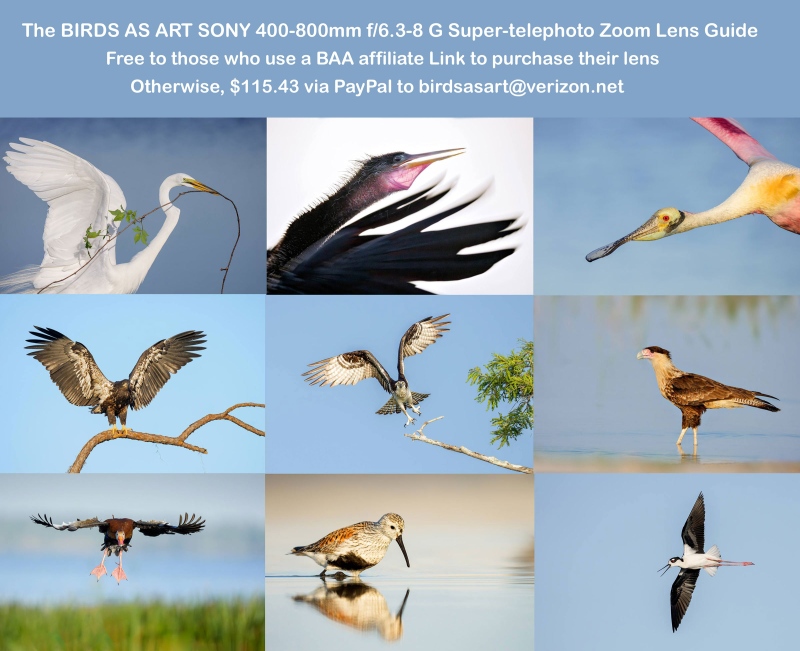
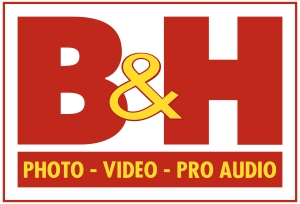

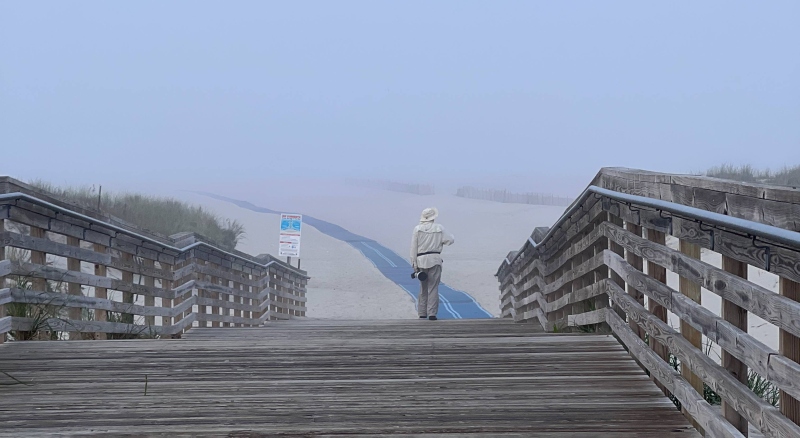
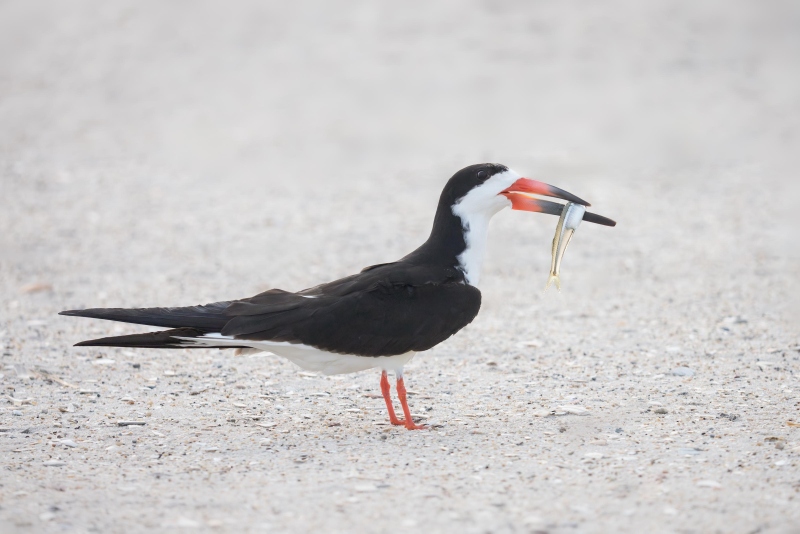
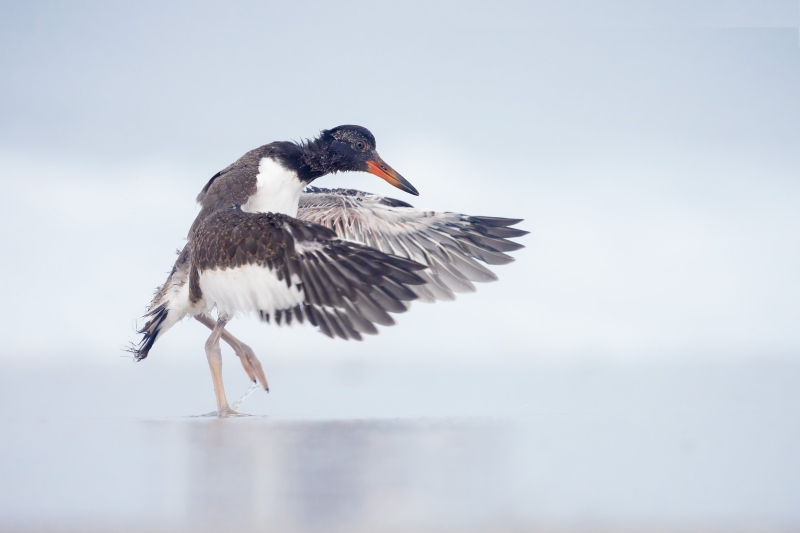
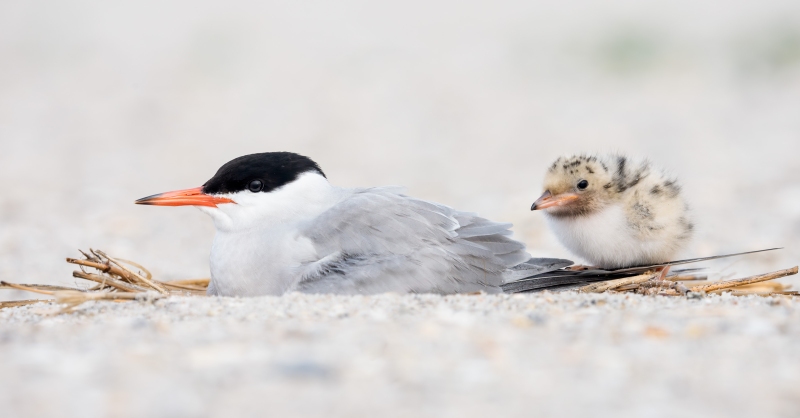
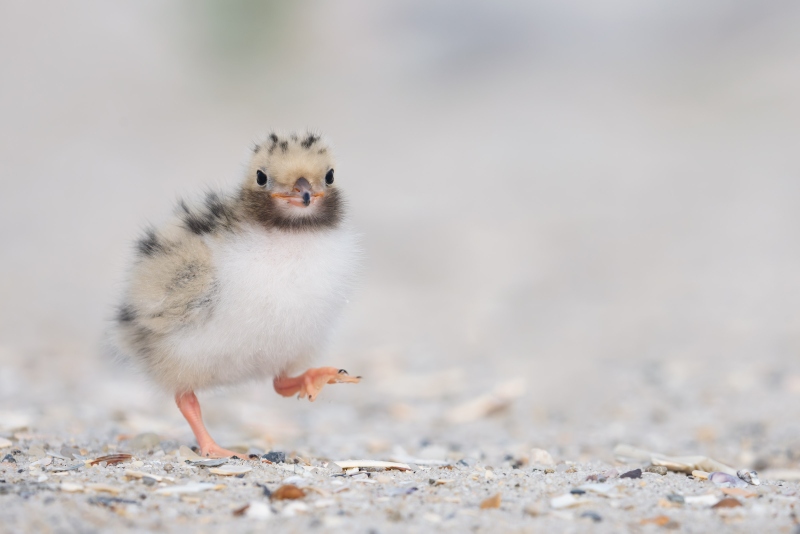
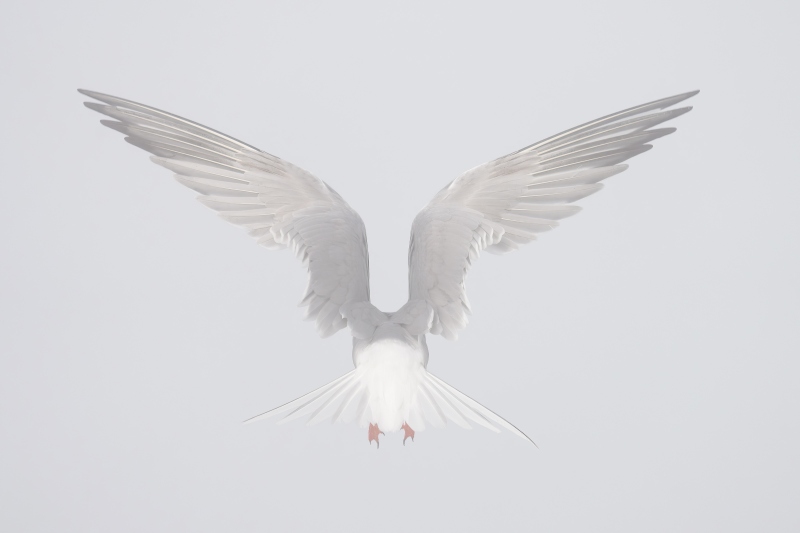
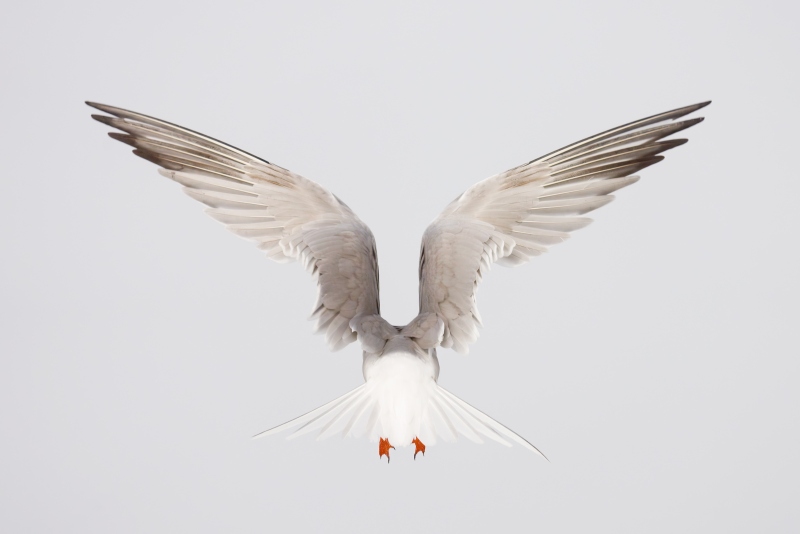
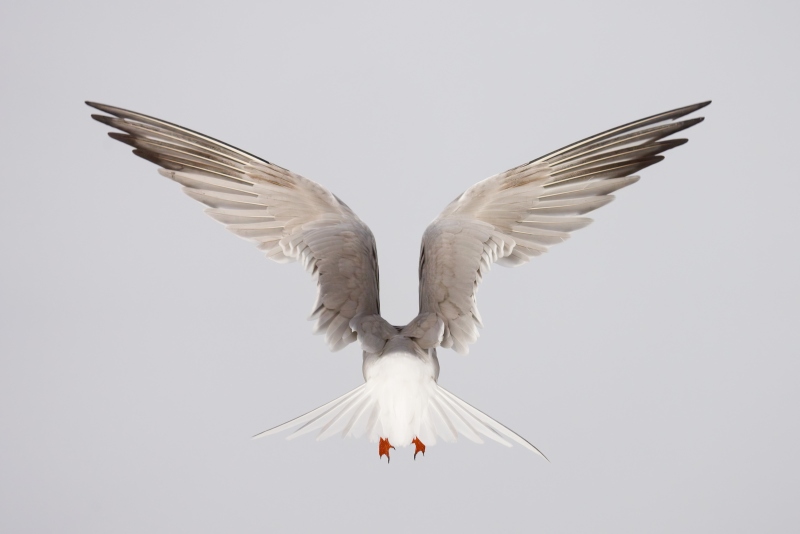
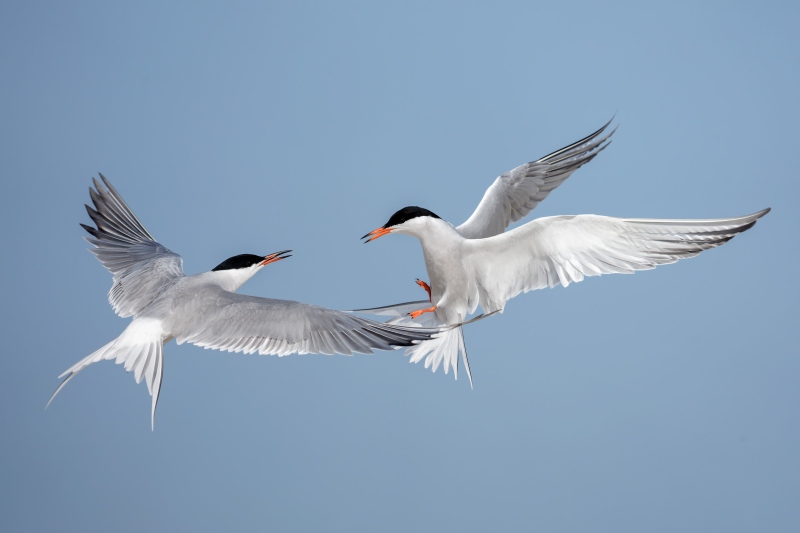






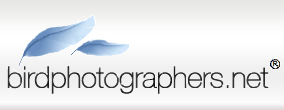


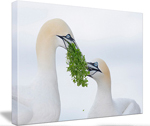
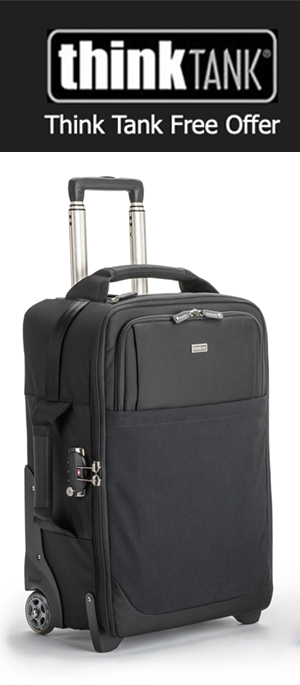


I forgot to ask. Where can I find definitions for the Knee and Foot pod methods? I’ve never heard of them until reading your blog. I purchased your 4-8 Lens Guide, and you mention the techniques but there is no explanation.
I made a video just for you but it was ruined by wind noise. I will try to do another one soon if we get a foggy day at Jacksonville.
a
Appreciate it.
Image Question
Which of the three foggy image optimizations do you like best, 6, 6A, or 6B? Why?
I like all the images, but I prefer #6 because the fog gave the bird an angelic-like look. 6B was a close second because of the contrast between the wingtips and the shoulders.
I have a question for you. As you may or may not recall I am 74. I have never been much of a post-production, image manipulation person. Partly because I’ve never had time to teach myself and partly because I prefer the get as close to right in the camera as I can that comes from being a studio photographer in the film days. Anyway, do you think I’d be wasting my money to purchase your Digital II and III Video Series?
Finally, of all the images in the June 26, 2025 post I really like the one of you crossing the bridge taken with the cellular phone. It reminds of “Footprints in the Sand” and for some reason the movie “Butch Cassidy and Sundance Kid” 1969.
Thanks for commenting.
Are you shooting raw or JPEG?
artie
Mostly raw unless it’s portrait in studio. Most of my people indoors is jpeg. All outdoors is raw.
Thanks
Please understand a few things: properly exposed to the right raw files should look washed out. So, unless you are under-exposing your raw files, it is not possible to “get it right in camera.”
What you call “manipulating” I call “optimizing.” For serious digital photographers, the raw file is what the negative was to Ansel Adams. You are therefore, missing the boat. I take great pleasure in bringing my images to life in Photoshop and teaching others to do the same. BTW, JI = JO. Junk in equals junk out. Photoshop cannot make bad images good. That said, DB and the video series have over the years helped many hundreds of folks learn to process their raw files.
artie
ps: Following up from AI Overview:
Ansel Adams was a renowned photographer known for his black and white landscape photography, and like all photographers of his era, he worked with film negatives to capture his images. Adams meticulously processed his film in the darkroom, developing the negatives and then creating prints from them. He famously said, “The negative is the score, the print is the performance”. This quote highlights his view of the negative as the foundation for his artistic prints.
I know who Ansel Adam’s is and his contribution to art of photography which by the helped to get photography to be considered art rather than a science. I also don’t use the manipulation as a criticism but let’s call it what is. I have no issue with people who have skills to post process their images (key word is “their”)to be the best they can be. It’s just that I don’t care to do. You can do what you want to your images (again, operative word is “your”). I don’t have issue making exposure corrections and I KNOW a raw file is like the equivalent of a negative film or slide. Just because I don’t earn my livelihood as a successful bird and wildlife photographer doesn’t mean my preferences are not valid. Everytime the subject of post manipulation those in favor of doing whatever they want to do to their images they bring Ansel Adam’s as if he was the Greek God of photography and that they know what he would or wouldn’t have done if had modern day software at his disposal. I am not at all convinced that Mr. Adam’s means what you think he meant when he said “the negative is the score, the print is the performance”. BTW, I agree with that and that is why I like to print digital photos for display in my environment. But your opinion is valid yet doesn’t mean mine isn’t.
All that said I would like to learn how to do a better job of “processing” my raw images for exposure. Live view is a blessing in that respect because it enable anyone to apply exposure settings so the image taken looks as close as possible to what the taker see with their naked eyes. What “the taker” cared to do in post is entirely between hers and his concious.
Hi George,
I’m responding in frame here as there was not another Reply button. You are of course free to think and do exactly what you want; I have no problem with that. In photography, the end image is what matters. The images speak to us and tell us a lot about the photographer. I invite you to re-post the link to your images so that folks can see the type of work you are producing. Then we’ll see if anyone has the guts to post an honest comment.
artie
#7 is my favorite image today. What a wonderful capture of the squabbling terns! As for the foggy images, my choice is #6, the really foggy one. The bird looks like an apparition.
Thanks Pat. I think that I work to hard to avoid the foggy look …
with love, artie
6b because the tail feathers have better contrast with the bg.
Thanks, J Marr. Different strokes!
with love, artie